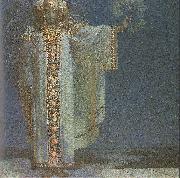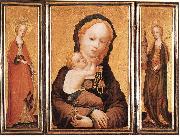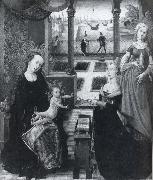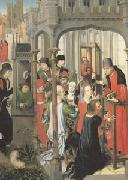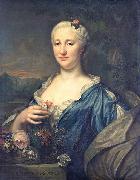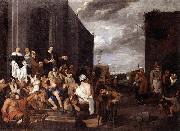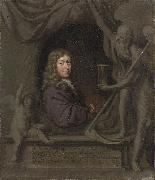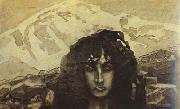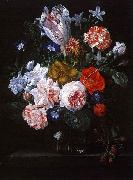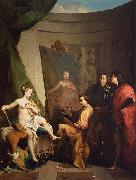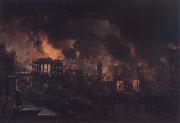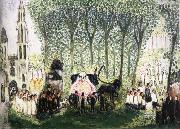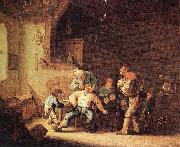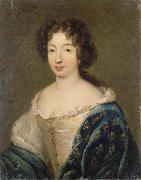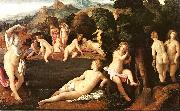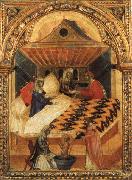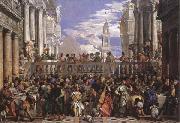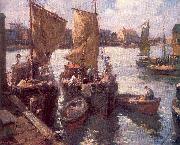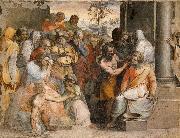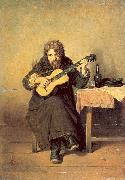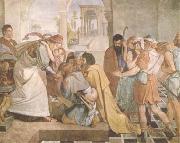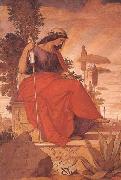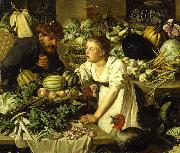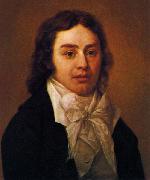|
|
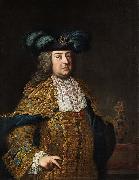 |
Martin van Meytens
|
|
(June 24, 1695 - March 23, 1770) was a Swedish-Austrian painter who painted members of the royal Court of Austria such as Marie Antoinette, Maria Theresa of Austria, Francis I, Holy Roman Emperor, the Emperor's family and others. His painting style has inspired many other painters to paint in a similar format.
|
|
|
|
|
|
|
|
|
|
|
|
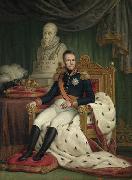 |
Mattheus Ignatius van Bree
|
|
was a Belgian painter, sculptor and architect.
He was born at Antwerp in 1773, was instructed by Regemorter; he afterwards went to Paris, and after having obtained by a 'Cato in Utica' the second prize for Rome, he went to that city in 1797e returning to his native country in 1804.[1] He painted numerous historical pictures, some of which are of large dimensions, and obtained a high reputation in Flanders. His conceptions are frequently poetical, and his compositions graceful, delineated with a light, free, and spirited pencil ; but his colouring is rather too florid in some instances.
He was first professor at the Academy of Fine Arts at Antwerp, and in 1827 its director. Member of several other scientific institutions like the academies of Amsterdam, Rome, Munich and New York. Among his most important works are 'The Patriotism of the Burgomaster Van der Werft,' in the Town-Hall at Leyden, and 'The Death of Rubens,' in the Museum at Antwerp. He brought forward some of the most eminent of the later Flemish painters, among whom are Wappers, De Keyser, F. de Braekeleer, and others of whom their country is justly proud. Van Bree died at Antwerp in 1839.
|
|
|
|
|
|
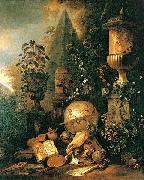 |
Matthias Withoos
|
|
(1627-1703), also known as Calzetta Bianca and Calzetti, was a Dutch painter of still lifes and city scenes, best-known for the details of insects, reptiles and undergrowth in the foreground of his pictures.
Withoos was born in Amersfoort. He studied under Jacob van Campen, at his painters' school just outside the city at his country house, and then with Otto Marseus van Schrieck. When he was 21, Withoos made a trip to Rome with Van Schrieck, and Willem van Aelst. There they joined the group of northern artists known as the "Bentvueghels" ("Birds of a feather"), and Withoos went by the alias "Calzetta Bianca" ("White Hose") a translation of his name into Italian. Withoos' work caught the eye of the cardinal Leopoldo de Medici, who commissioned various paintings from him.
In 1653, the artist returned to Amersfoort.When French troops occupied Amersfoort in the "Disastrous Year" of 1672, Withoos fled from Amersfoort to Hoorn, where he would remain until his death in 1703. |
|
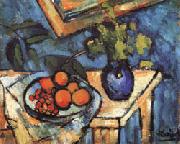 |
maurice de vlaminck
|
|
maurice de vlaminck,1876 to 1958,French painter, printmaker, draughtsman and writer. His nature, character, tastes and way of life were in perfect harmony with the freedom, daring and violence of his painting. He was brought up in a musical environment: his father, of Flemish origin, was a violin teacher and his mother, from Lorraine, was a piano teacher. He studied music himself to quite a high standard and later played the double-bass (and sometimes the bass drum, a source of considerable pleasure) in his regimental band. His family had come to live at Le V?sinet near Paris, and he spent his childhood both there and later at Chatou on the Seine. From 1892 he began to take an interest in painting, though he worked as a mechanic and became a racing cyclist.
|
|
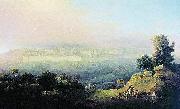 |
Maxim Nikiforovich Vorobiev
|
|
(1787-1855) was a Russian Romantic landscape painter.
Vorobiev was born into the family of a soldier, who on retirement became a guard in the Academy of Arts in St. Petersburg. There, Maxim was admitted in 1798 where he initially studied architecture but graduated as a landscape painter in 1809.
|
|
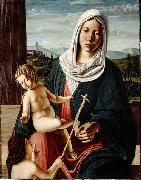 |
Michele da Verona
|
|
(Michele di Zenone) (born 1470) was an Italian painter of the Renaissance period.
He was born in Verona, a contemporary of Paolo Morando(Cavazzola), and may have assisted him in the decorative work for San Bernardino there. Inside the portal of San Stefano, Milan, is a large Crucifixion signed by him in 1500, and formerly in the Refectory of San Giorgio, of Verona. The same subject, dated by him in 1505, is in Santa Maria in Vanzo, Padua. In both pictures there is an imitation of the manner of Jacopo Bellini. In the church of Santa Chiara, Verona, are frescoes representing the Eternal, with Angels, Prophets, and the four Evangelists, dated 1509. Frescoes of later dates exist in the churches of Vittoria Nuova and Sant' Anastasia; while in the church of Villa di Villa, near Este, is a Madonna and Child, between SS. John the Baptist, Lawrence, Andrew, and Peter dated 1523.
|
|
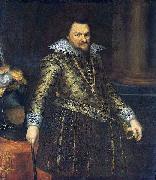 |
Michiel Jansz. van Mierevelt
|
|
(Delft, 1567 - Delft 27 June 1641) was a Dutch Golden Age painter.
He was the son of a goldsmith, who apprenticed him to the copperplate engraver Hieronymus Wierix. He subsequently became a pupil of Willem Willemz and Augusteyn of Delft, until Anthonie van Montfoort (Houbraken calls him Antony Blokland), who had seen and admired two of Mierevelt's early engravings, Christ and the Samaritan and Judith and Holofernes, invited him to enter his school at Utrecht.
He registered as a member of the Guild of St. Luke in The Hague in 1625.Devoting himself first to still lifes, he eventually took up portraiture, in which he achieved such success that the many commissions entrusted to him necessitated the employment of numerous assistants, by whom hundreds of portraits were turned out in factory fashion. Today over 500 paintings are or have been attributed to him.The works that can with certainty be ascribed to his own brush are remarkable for their sincerity, severe drawing and harmonious color, but comparatively few of the two thousand or more portraits that bear his name are wholly his own handiwork. So great was his reputation that he was patronized by royalty in many countries and acquired great wealth. The king of Sweden and the count palatine of Neuburg presented him with golden chains; Albert VII, Archduke of Austria, at whose court he lived in Delft, gave him a pension; and Charles I vainly endeavoured to induce him to visit the English court.
Though Mierevelt is chiefly known as a portrait painter, he also executed some mythological pieces of minor importance. Many of his portraits have been reproduced in line by the leading Dutch engravers of his time. He died at Delft.
The Rijksmuseum in Amsterdam has the richest collection of Mierevelt's works, chief of them being the portraits of William, Philip William, Maurice, and Frederick Henry of Orange, and of the count palatine Frederick V. At the Mauritshuis in The Hague are the portraits of four princes of the house of Orange, of Frederick V as king of Bohemia, and of Louise de Coligny as a widow. Other portraits by him are at nearly all the leading continental galleries, notably at Brunswick (3), Gotha (2), Schwerin (3), Munich (2), Paris (Louvre, 3), Dresden (4), Berlin (2), and Darmstadt (3). The town hall of Delft also has numerous examples of his work.
|
|
|
|
|
|
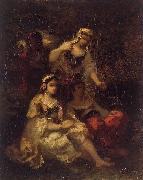 |
Narcisse Virgilio Diaz
|
|
August 25, 1807-November 18, 1876) was a French painter of the Barbizon school.
Diaz was born in Bordeaux to Spanish parents. At the age of ten, Diaz became an orphan, and misfortune dogged his early years. His foot was bitten by a reptile in Meudon wood, near Sevres, where he had been taken to live with some friends of his mother. The bite was poorly dressed, and ultimately he lost his leg. However, as it turned out, the wooden stump that replaced his leg became famous.
At fifteen he entered the studios at Sevres, first working in the decoration of porcelain occupied him and later turning to painting. Turkish and Oriental scenes attracted him, and he took to painting Eastern figures dressed in richly coloured garments; many of these paintings remain extant. He also spent much time at Barbizon.
At Fontainebleau Diaz found Rousseau painting his wonderful forest pictures, and was determined to paint in the same way if possible. However, Rousseau was then in poor health, embittered against the world, and consequently was difficult to approach. On one occasion, Diaz followed him surreptitiously to the forest, wooden leg not hindering, and he dodged round after the painter, trying to observe his method of work. After a time Diaz found a way to become friendly with Rousseau, and revealed his eagerness to understand the latter's techniques. Rousseau was touched with the passionate words of admiration, and finally taught Diaz all he knew.
Diaz exhibited many pictures at the Paris Salon, and was decorated in 1851. During the Franco-German War he went to Brussels. After 1871, his works became fashionable and rose gradually in the estimation of collectors, and he worked constantly and successfully. Diaz's finest pictures are his forest scenes and storms, and it is on these that his fame rests. There are several examples of his work in the Louvre, and three small figure pictures in the Wallace Collection, Hertford House. |
|
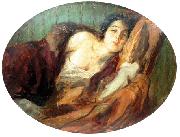 |
Nicolae Vermont
|
|
(October 10, 1866 - June 14, 1932) was a Romanian realist painter, graphic artist and muralist. He was noted for his wide range of subjects and his interest in social issues, and was an associate of the post-Impressionists Ştefan Luchian and Constantin Artachino, as well as a friend of the controversial art collector and political figure Alexandru Bogdan-Piteşti.
Born in Bacău, Vermont belonged to the Jewish community. Late in his life, Vermont abandoned Judaism and converted to the Romanian Orthodox Church.
He began his career in 1884, as a contributor to the journal Universul, while studying with Theodor Aman at the Academy of Fine Arts in Bucharest (graduated 1886). Vermont completed his training at the Munich Akademie der Bildenden Kenste (1893). He was able to attend the latter institution after being endorsed by the major Romanian artist Nicolae Grigorescu. |
|
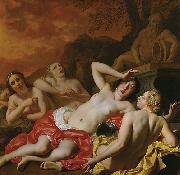 |
Nicolaes van Helt Stockade
|
|
(1614-1669), was a Dutch Golden Age painterAccording to Houbraken, Joost van den Vondel made a poem about him.
According to the RKD he became a master in the Antwerp Guild of Saint Luke in 1646 and worked on the city hall of Nijmegen and the Amsterdam City Hall.
|
|
|
|
|
|
|
|
|
|
|
|
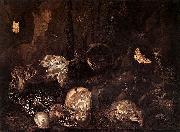 |
Otto Marseus van Schrieck
|
|
(ca. 1619, Nijmegen - buried June 22, 1678, Amsterdam) was a painter in the Dutch Golden Age.
Marseus van Schrieck spent the years 1648-1657 in Rome and Florence with the painters Matthias Withoos and Willem van Aelst, after which he settled in Amsterdam. He is best known for his paintings of forest flora and fauna. In Arnold Houbraken's biography of him, he mentions that he joined the Bentvueghels in Rome and was called the snuffelaer, or "sniffer", because he was always sniffing strange lizards and snakes. He quotes his wife, who apparently survived him by two husbands and was still alive when he wrote the book. He wrote that she said that Otto kept snakes and lizards in a shed at the back of his house, and also on a piece of land outside the city that was walled in for this purpose.
|
|
|
|
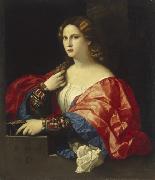 |
Palma il Vecchio
|
|
(c. 1480 - July 1528), born Jacopo Palma or known as Jacopo Negretti, was an Italian painter of the Venetian school born at Serina Alta near Bergamo. He is called Palma Vecchio in English ("Old Palma" - in Italian Palma il Vecchio) to distinguish him from Palma Giovane, his great-nephew.
When Palma arrived in Venice early in the 16th century, he reputedly was a companion and competitor of Lorenzo Lotto, and to some extent a pupil of Titian. He may also have taught Bonifazio Pitati and influenced Giovanni Busi. Palma's earlier works betray the influence of the Bellini. |
|
|
|
|
|
|
|
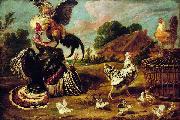 |
Paul de Vos
|
|
(1591e1592, or 1595, Hulst-30 June 1678, Antwerp) was a Flemish Baroque painter.
De Vos was born in Hulst near Antwerp, now in the Dutch province of Zeeland. Like his older brother Cornelis and younger brother Jan, he studied under the little-known painter David Remeeus (1559-1626). He specialized in monumental animal scenes, especially hunts for aristocratic patrons, that are heavily influenced by Frans Snyders (to whom his sister Margaretha was married). De Vos became a master and joined the guild of St. Luke in 1620.
As was frequent amongst artists in Antwerp, De Vos frequently collaborated with other painters. He painted animals in hunting scenes and armor in mythologies by Peter Paul Rubens and his studio. He also worked with Thomas Willeboirts Bosschaert, Erasmus Quellinus II, Anthony van Dyck, and Jan Wildens.
|
|
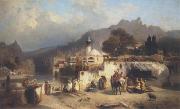 |
Paul von Franken
|
|
(1818- 1884 ) - Painter
painted Paul von Franken. View of Tiflis in 1866
|
|
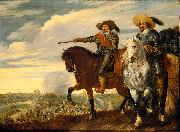 |
Pauwels van Hillegaert
|
|
(1596-1640) was a Dutch Golden Age painter of landscapes and military scenes.
He married Anneken Homis from Antwerp in 1620, with whom he had several children, including the painter with the same name, Pauwels van Hillegaert II (1621-1658). This Pauwels Jr. married Cornelia de Vlieger (daughter of Simon de Vlieger) and had two daughters. When Pauwels Jr. like his father died at a relatively young age, Cornelis de Bie wrote a commemorative poem about him.
Pauwels Sr. won royal commissions to paint battle scenes, most notably for the Siege of 's-Hertogenbosch in 1629. He also won a commission for the Battle of Nieuwpoort. He also painted Italianate landscapes, but was mostly admired for his horses and armor.
|
|
|
|
|
|
|
|
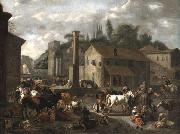 |
Peter van Bloemen
|
|
Pieter van Bloemen, called Standaart (bapt. 17 January 1657 - 6 March 1720), first name also spelled Peter or Peeter, was a Flemish painter.
Van Bloemen was born in Antwerp, where he attained the status of master at the age of 17. He then went to Rome, where he remained until 1694, adopting completely Italian manners. In 1699 he became dean of the Guild of Saint Luke in Antwerp. He was the teacher of his younger brother Jan Frans van Bloemen, a highly regarded painter of classical landscapes. The brothers travelled widely together, often collaborating on works, with Pieter taking on the role of figurista in Jan Frans' vedute, a role he also performed for many other artists. |
|
|
|
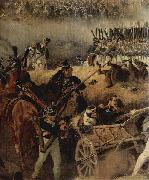 |
Peter von Hess
|
|
(29 July 1792, Dseldorf - 4 April 1871, Menchen) was a German painter, known for historic paintings, especially of the Napoleonic Wars and the Greek War of Independence.
Peter von Hess initially received training from his father Carl Ernst Christopher Hess. He accompanied his younger brother Heinrich Maria to Munich in 1806, and enrolled at the Munich Academy at the age of sixteenth. He also trained under Wilhelm von Kobell.
During the Napoleonic Wars, he was allowed to join the staff of General Wrede, who commanded the Bavarians in the military operations which led to the abdication of Napoleon. There he gained novel experiences of war and a taste for extensive travel. During this time, von Hess painted his first battle pieces. In 1818 he spent some time in Italy where he painted landscapes and various Italian scenes.
In 1833, at Ludwig's request, he accompanied Otto of Greece to the newly formed Kingdom of Greece, where at Athens he gathered materials for pictures of the war of liberation. The sketches which he then made were placed, forty in number, in the Pinakothek, after being copied in wax on a large scale by Nilsen, in the northern arcades of the Hofgarten at Munich. King Otho's entrance into Nauplia was the subject of a large and crowded canvas now in the Pinakothek, which Hess executed in person.
|
|
|
|
|
|
|
|
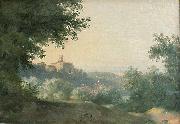 |
Pierre-Henri de Valenciennes
|
|
(December 6, 1750 - February 16, 1819) was a French painter.
Valenciennes worked in Rome from 1778 to 1782, where he made a number of landscape studies directly from nature, sometimes painting the same set of trees or house at different times of day.He theorized on this idea in Advice to a Student on Painting, Particularly on Landscape (1800), developing a concept of a "landscape portrait" in which the artist paints a landscape directly while looking upon it, taking care to capture its particular details.Although he spoke of this as a type of painting mainly of interest to "amateurs", as distinguished from the higher art of the academies, he found it of great interest, and of his own works the surviving landscape portraits have been the most noted by later commentators. He in particular urged artists to capture the distinctive details of a scene's architecture, dress, agriculture, and so on, in order to give the landscape a sense of belonging to a specific place; in this he probably influenced other French artists active in Italy who took an anthropological approach to painting rural areas and customs, such as Hubert Robert, Pierre-Athanase Chauvin and Achille-Etna Michallon. |
|
|
|
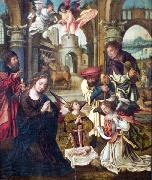 |
Pieter Coecke van Aelst
|
|
(August 14, 1502 - December 6, 1550) was a Flemish painter. He studied under Bernaert van Orley and later lived in Italy before entering the Antwerp Guild of painters in 1527. In 1533, he travelled to Constantinople for one year in a failed attempt to establish business connections for his tapestry works. Van Aelst established a studio in Brussels in 1544, where he created paintings and tapestries. His students include Gillis van Coninxloo, Willem Key, Hans Vredeman de Vries, Michiel Coxcie, and possibly Pieter Brueghel the Elder, who did eventually marry van Aelst's daughter, Mayken. His second wife, Mayken Verhulst, was an artist as well, and, according to Carel van Mander, the first teacher of her grandchildren, Pieter Brueghel the Younger and Jan Brueghel the Elder. He was also the uncle of Joachim Bueckelaer. Van Aelst's studio is also well known for its engraved works.
In particular, van Aelst is noted for his 1539 translation of Sebastiano Serlio's architectural treatise, Architettura, which is credited with having played a crucial role in spreading Renaissance ideas to the Low Countries and hastening the transition from the late Gothic style prevalent in the area at the time. He was in charge of the spectacular decorations for the 1549 Royal entry into Antwerp of Philip II of Spain, "the most famous entry of the century", according to Roy Strong.
|
|
|
|
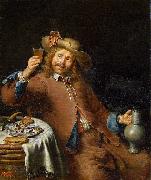 |
Pieter Cornelisz. van Slingelandt
|
|
(20 October 1640 - 7 November 1691) was a Dutch Golden Age painter.
According to Houbraken, his teacher was Gerard Dou, who he imitated so well that many of his works were later misattributed to him. According to Houbraken he was rather introverted and very methodical and conscientious, spending months on his works and striving for perfection. Houbraken especially liked a piece where a maid holds a mouse by the tail as a cat jumps for it.
Houbraken wrote that while Slingelandt was working on a family portrait for the gentleman Francois Meerman (1630-1672), |
|
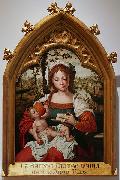 |
Pieter van Aelst
|
|
(August 14, 1502 - December 6, 1550) was a Flemish painter. He studied under Bernaert van Orley and later lived in Italy before entering the Antwerp Guild of painters in 1527. In 1533, he travelled to Constantinople for one year in a failed attempt to establish business connections for his tapestry works. Van Aelst established a studio in Brussels in 1544, where he created paintings and tapestries. His students include Gillis van Coninxloo, Willem Key, Hans Vredeman de Vries, Michiel Coxcie, and possibly Pieter Brueghel the Elder, who did eventually marry van Aelst's daughter, Mayken. His second wife, Mayken Verhulst, was an artist as well, and, according to Carel van Mander, the first teacher of her grandchildren, Pieter Brueghel the Younger and Jan Brueghel the Elder. He was also the uncle of Joachim Bueckelaer. Van Aelst's studio is also well known for its engraved works.
In particular, van Aelst is noted for his 1539 translation of Sebastiano Serlio's architectural treatise, Architettura, which is credited with having played a crucial role in spreading Renaissance ideas to the Low Countries and hastening the transition from the late Gothic style prevalent in the area at the time. He was in charge of the spectacular decorations for the 1549 Royal entry into Antwerp of Philip II of Spain, "the most famous entry of the century", according to Roy Strong.
|
|
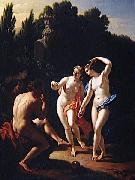 |
Pieter van der Werff
|
|
(1665 - September 26, 1722) was a Dutch Golden Age painter. He assisted his older brother, Adriaen van der Werff.
He learned to paint from his brother Adriaen and according to the RKD, he spent most of his life working in Rotterdam, where he painted the rich and famous |
|
|
|
|








